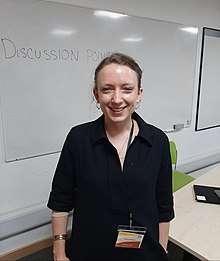Lisa Lodwick
Lisa Lodwick FSA is an archaeologist who studies charred, mineralised and waterlogged macroscopic plant remains, and uses carbon and nitrogen stable isotope analysis to understand the crop husbandry practices of the ancient Romans.
Lisa Ann Lodwick | |
|---|---|
 Dr Lisa Lodwick in December 2019 | |
| Nationality | British |
| Alma mater | University of Oxford |
| Scientific career | |
| Fields | Archaeology |
| Institutions | All Souls College, Oxford |
| Thesis | An Archaeobotanical Analysis of Silchester and the wider region across the Late Iron Age - Roman Transition (2014) |
| Doctoral advisor | Mark Robinson |
| Website | https://lisalodwick.com/ |
Lodwick's pioneering archaeobotanical studies at Calleva Atrebatum have demonstrated the import and consumption of celery, coriander and olive in Insula IX prior to the Claudian Conquest.[1][2]
Education
Lodwick graduated with a DPhil from the School of Archaeology, University of Oxford in 2014.[3] In 2009 Lodwick won the Meyerstein Prize[4] which is awarded to the candidate whose performance in the Second Public Examination (Final Honour School) has been adjudged the best in the year. Lodwick completed her undergraduate degree in Archaeology and Anthropology at Hertford College, University of Oxford in 2009.
Career
Lodwick was a post-doctoral researcher at the Department of Archaeology, University of Reading from 2014-2017.[3] She is currently a post-doctoral research fellow at All Souls College, Oxford.[5] Lodwick advocates Open Access publication in archaeology. She is the co-founder and editor-in-chief of the Theoretical Roman Archaeology Journal,[6] published by the Open Library of Humanities. She is a member of the Editorial Board of the journal Britannia published by the Society for the Promotion of Roman Studies.[7]
Lodwick was elected a Fellow of the Society of Antiquaries of London (FSA) in November 2018.[8]
Select publications
- Lodwick, L. (2019). "Agendas for Archaeobotany in the 21st Century: data, dissemination and new directions". Internet Archaeology. 53. doi:10.11141/ia.53.7.
- Lodwick, L. (2019). "Farming practice, ecological temporality, and urban communities at a late Iron Age oppidum". Journal of Social Archaeology. 19 (2). doi:10.1177/1469605319837766.
- Lodwick, L. A. (2018). "Arable weed seeds as indicators of regional cereal provenance: a case study from Iron Age and Roman central-southern Britain" (PDF). Vegetation History and Archaeobotany. 27 (6): 801–815. doi:10.1007/s00334-018-0674-y. ISSN 0939-6314.
- Smith, A.; Allen, M.; Brindle, T.; Fulford, M.; Lodwick, L; Rohnbogner, A (2018). New visions of the countryside of Roman Britain volume 3: life and death in the countryside of Roman Britain. Britannia Monographs Series. 31. London: Society for the Promotion of Roman Studies. p. 437. ISBN 9780907764465.
- Lodwick, L. A. (2017). "Agricultural innovations at a Late Iron Age oppidum: archaeobotanical evidence for flax, food and fodder from Calleva Atrebatum, UK". Quaternary International. 460: 198–219. doi:10.1016/j.quaint.2016.02.058. ISSN 1040-6182.
- Lodwick, L. A. (2017). "Evergreen plants in Roman Britain and beyond: movement, meaning and materiality" (PDF). Britannia. 48: 135–173. doi:10.1017/S0068113X17000101. ISSN 1753-5352.
- Allen, M.; Lodwick, L.; Brindle, T.; Fulford, M; Smith, A. (2017). New visions of the countryside of Roman Britain volume 2: the rural economy of Roman Britain. Britannia Monograph Series. 30. London: Society for the Promotion of Roman Studies. p. 480. ISBN 9780907764441.
- Lodwick, L. A. (2017). "'The debatable territory where geology and archaeology meet': reassessing the early archaeobotanical work of Clement Reid and Arthur Lyell at Roman Silchester" (PDF). Environmental Archaeology. 22 (1): 56–78. doi:10.1080/14614103.2015.1116218. ISSN 1461-4103.
References
- Lodwick, Lisa (1 September 2014). "Condiments before Claudius: new plant foods at the Late Iron Age oppidum at Silchester, UK". Vegetation History and Archaeobotany. 23 (5): 543–549. doi:10.1007/s00334-013-0407-1. ISSN 0939-6314.
- Lodwick, Lisa A. (7 January 2016). "'The debatable territory where geology and archaeology meet': reassessing the early archaeobotanical work of Clement Reid and Arthur Lyell at Roman Silchester" (PDF). Environmental Archaeology. 22 (1): 56–78. doi:10.1080/14614103.2015.1116218. ISSN 1461-4103.
- "Staff Profile:Dr Lisa Lodwick". University of Reading. Retrieved 3 December 2018.
- "Student Prizes, School of Archaeology". www.arch.ox.ac.uk.
- "Dr. Lisa Lodwick". All Souls College Oxford. Retrieved 3 December 2018.
- "Theoretical Roman Archaeology Journal". TRAC. TRAC. 10 May 2017.
- "About Us - Britannia Editorial Board". Society for the Promotion of Roman Studies. Retrieved 1 November 2019.
- Fellows Directory. "Society of Antiquaries". sal.org.uk. Retrieved 3 December 2018.